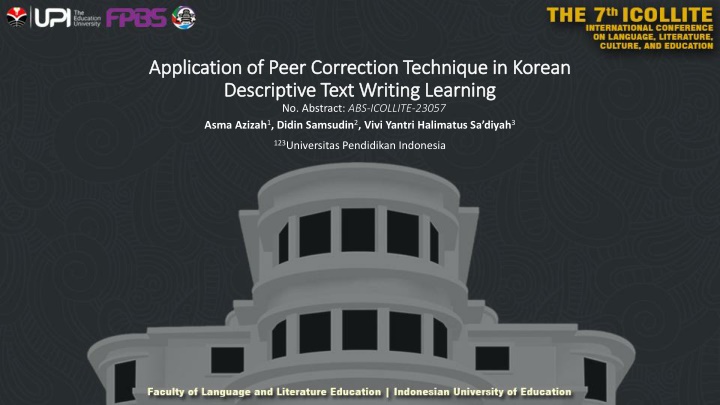
Enhancing Korean Descriptive Text Writing Through Peer Correction Technique
Explore the effectiveness of peer correction technique in improving Korean descriptive text writing skills. Research findings show positive impacts on students' abilities and peer relationships in language learning.
Download Presentation

Please find below an Image/Link to download the presentation.
The content on the website is provided AS IS for your information and personal use only. It may not be sold, licensed, or shared on other websites without obtaining consent from the author. If you encounter any issues during the download, it is possible that the publisher has removed the file from their server.
You are allowed to download the files provided on this website for personal or commercial use, subject to the condition that they are used lawfully. All files are the property of their respective owners.
The content on the website is provided AS IS for your information and personal use only. It may not be sold, licensed, or shared on other websites without obtaining consent from the author.
E N D
Presentation Transcript
Application of Peer Correction Technique in Korean Application of Peer Correction Technique in Korean Descriptive Text Writing Learning Descriptive Text Writing Learning No. Abstract: ABS-ICOLLITE-23057 Asma Azizah1, Didin Samsudin2, Vivi Yantri Halimatus Sa diyah3 123Universitas Pendidikan Indonesia
INTRODUCTION There is a need to enhance writing skills in the field of the Korean language because writing in Korean is more complex compared to spoken language. There is a need for the development of new teaching models in the Korean language, as there has been no evaluation conducted specifically with peer correction. There is a lack of studies focusing on peer correction in writing instruction, particularly for descriptive texts in the Korean language in Indonesia.
LITERATURE REVIEW Song (2015) examined the effectiveness of the peer correction technique in his study that the technique was positively received by students and was considered successful in improving peer relationships as well as their ability to self-correct. Kim (2016) has conducted a study focusing on the application of peer correction conducted in a writing academy class where the results showed that peer correction technique can be an alternative in learning writing. Emelda (2019) conducted a study focusing on the comparison of two correction techniques namely, peer correction and self-correction in English descriptive text writing activities. This research shows that peer correction is considered more influential on the ability to write descriptive texts. Sunahase, et al (2019) through their research, showed that the way of evaluation using this technique is considered more effective because it really helps learners and makes them know how far their abilities are, not only in writing, but also giving corrections. Melinda's (2020) findings show that teacher correction is more effective in learning than peer correction. This is because students' correction skills are different and they tend to be confused in determining the correctness of their friends' answers.
METHOD This research utilizes a descriptive qualitative research The data collected through observations, questionnaires, and interviews. The collected test data analyzed in terms of maximum, minimum, and mean scores. Meanwhile, the observational data, questionnaires, and interviews went through a process of reduction, presentation, and interpretation in order to draw conclusions.
FINDING AND DISCUSSION Table 1 Descriptive Data Analysis Category test Number Minimum score Maximum score Average Based on the table 1, out of the 28 students in the class, the minimum score obtained in the pre-test was 33, while the maximum score was 87. In the post-test, the minimum score was 40, and the maximum score was 90. The average score in the pre-test was 55.43, while in the post-test it was 60.00. Table 2 shows that each assessed component in this test has experienced an improvement. There was an increase of 8.5% in content, 10.5% in composition, 4.9% in vocabulary, 6.3% in grammar, and 14% in functional aspects. Although the numbers may not appear significant at first glance, it is important to note the specific indicators for each component. Pre-Test 28 33 87 55.43 Post-Test 28 40 90 60.00 Table 2 Percentage Improvement of Evaluation Component Indicators of Assessment Content Pre-Test Post-Test Difference Percentage 317 344 27 8,5% Composision 313 346 33 10,5% Vocabulary 306 321 15 4,9% Grammar 431 458 27 6,3% Functional Parts 185 211 26 14%
FINDING AND DISCUSSION Table 3 Comparison of Corrections by Students and Teachers Correction by Teacher Correction by Students . . . . . . . . (.............) Notes: 2 14 . . . . . 8 . . . (............) The teacher provided corrections related to vocabulary and grammar that were deemed inaccurate. The teacher also marked parts that, according to them, should be removed as they did not align with the preceding and succeeding sentences. The teacher provided recommendations or suggested answers. The students were only able to provide minimal corrections in terms of grammar, and there were no recommendations or further discussions included in the correction results. - The second sentence is less comprehensible - - - -> -> -> .
FINDING AND DISCUSSION Table 4 Results of Questionnaires Asked to Learners Strongly Agree 31% Moderately Agree 37% Strongly Disagree 3% No. Indicators Statement Agree Disagree 1. Knowledge I understand the procedure for implementing the peer correction technique. I feel comfortable when my friends correct my work. Critical attitude I think critically when implementing the peer correction technique. Interest I feel confident in practicing the peer correction technique. I agree if the peer correction technique is applied again in the future in other courses. Usefulness I feel helped by my friend's correction. I gain knowledge from my friends' correction of my work. I feel that my writing skills have improved because of the peer correction technique. 26% 3% 2. Comfort 20% 34% 26% 20% 0% 3. 11% 40% 46% 3% 0% 4. 3% 20% 61% 14% 2% 3% 37% 34% 23% 3% 5. 28% 40% 17% 9% 6% 26% 43% 20% 3% 8% 20% 37% 32% 11% 0%
FINDING AND DISCUSSION The students perceive peer correction as highly beneficial. They feel assisted by the written corrections provided on their written work. The students also become more aware of their individual writing abilities. Despite having several benefits, the students also acknowledge some shortcomings in this peer correction technique. The perceptions of the students, both the advantages and disadvantages, align with the perceptions of the teacher as a facilitator in implementing peer correction in the classroom. Considering the advantages and disadvantages of each correction technique, the teacher concludes that both peer correction and teacher correction can be alternately implemented in the classroom.
CONCLUSION Based on the results of the pre-test and post-test scores, there is an average increase in student writing results of 4.57. Based on the results of the questionnaire and interviews, it can be concluded that peer correction when applied to basic level Korean learners has disadvantages and advantages. Despite the disadvantages, at the basic level with the right procedures/application to aspects and levels, and with the help of teacher correction, peer correction can be used as an alternative in learning to write.
REFERENCES Choon, S. S. (2015). The Effect of Peer Correction in English Writing Guidance Class: Focusing on Graduate Students of the Department of English Education. Dan, X., & Feng, Q. (2015). Effectiveness of the Error Correction Strategies in Improving Senior High Heui, K. C. (2019). A Study on Integrated Reading and Writing Education Plans in Korean Language Education. 3-5. Heui, K. Y. (2014). Reconstruction of Language Resources and Language Proficiency: The Case of Early Korean Students Studying in Singapore and Their Accompanying Families. Comparative Cultural Studies. Hwa, K. H. (2005). . 389-396; 430-437; 445-448. Melinda, S. (2020). The Effect of Different Types of Correction in Writing Descriptive Text at Students of IAIN Palangka Raya. Rok, K. J. (2016). Analysis of The Effectiveness of Procedural Writing Education through Peer Correction. Korean Citation Index. Sumponogati, S. (2019). The Impact of Peer and Teacher Corrections to the Students Paragraph Writing in Discussion Text: Experimental Research to the 1st Semester Students of Technology Faculty at UNISBANK Semarang 2017/2018. Yeon, L. S. (2016). A Study on The Construction and Utilization of Text Genre Information for Korean Reading and Writing Education. 4-6. Yoandita, P. E. (2019). An Analysis of Students' Ability and Difficulties in Writing Descriptive Text. Jurnal JOEPALLT. Yohanes, R. S. (2010). Teori Vygotsky dan Implikasinya terhadap Pembelajaran Matematika. Youn-Sung Kim, T.-Y. K. (2020). A Case Study on the Diversity of International Co-produced Drama.International Journal of Internet, Broadcasting and Communication. Zainal, A. (2016). Evaluasi Pembelajaran. Bandung: Remaja Rosdakarya.
THANK YOU! Follow us @halssaady @asma.azizah @didinsamsudin282


